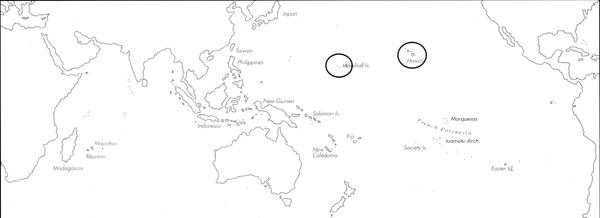
Skip Navigation Links
View access keys for this site.

Range: Hawaiian Archipelago; probably Fanning Is. and Enewetak, Marshall Islands.
Description: Small to medium-sized, moderately solid to solid. Last whorl usually broadly conical, outline variably convex. Shoulder angulate to rounded, tuberculate. Spire of low to moderate height, outline straight to convex. Larval shell of about 4 whorls. Postnuclear spire whorls tuberculate. Teleoconch sutural ramps flat to slightly concave, with 2 increasing to 3-5 spiral grooves. Last whorl with weak to obsolete spiral ribs on basal third; in smaller specimens, followed by spaced punctate grooves up to shoulder.
| Shell Morphometry | ||
|---|---|---|
| L | 20-58 mm | |
| RW | 0.10-0.50 g/mm (L 18-45 mm) | |
| RD | 0.70-0.83 | |
| PMD | 0.83-0.92 | |
| RSH | 0.09-0.22 | |
Ground colour bluish grey. Last whorl with 2-3 paler spiral bands, at shoulder, below centre and often within adapical third. Very fine brown or olive axial lines usually forming spiral bands above base, centrally and below pale subshoulder band. Variably spaced spiral rows of dark brown dots extending from base to shoulder. Teleoconch sutural ramps with inconspicuous brown dots or fine axial lines between tubercles. Aperture brownish violet, with pale bands below shoulder and at centre.
Periostracum yellow, thin, and translucent.
Foot pale brown; siphon pale brown, tinged with pink (Kohn, 1959a).
Radular teeth with an adapical barb opposite a long narrow blade extending halfway down the shaft; serration occurs on the inner margin close to the apex; base with a spur (James, 1980).
Habitat and Habits: Abundant on intertidal benches and common on subtidal reef platforms, where size is larger; occurring mainly to 15 m, a few specimens have been dredged in 100 m (Kohn & Weaver, 1962). C. abbreviatus inhabits mainly sand and algal turf on reef limestone (Kohn, 1959 b). C. abbreviatus feeds exclusively on polychaetes, mainly Eunicidae and Nereidae. Egg capsules 9-10 x 7-9 mm, deposited in rows and attached to the substratum by their basal plates, contain about 1,300 eggs, and about 44,000 eggs per egg mass. Egg diameter is 160-180 ┬Ám. The planktotrophic veliger has an observed pelagic period of 32 days (Perron 1981c; Perron & Kohn, 1985).
Discussion: The endemic Hawaiian species C. abbreviatus is closely related to C. miliaris, which is not known from Hawaii and differs in its smaller maximum size (ca. 40 mm), variously granulose surface and intermittent white dashes usually present within the dotted brown lines around the last whorl, and in the colour pattern of its animal. In spite of a 30-day pelagic period observed both in C. miliaris and C. abbreviatus, and occasional dispersal of C. abbreviatus to the Marshall and Line Is., no intermediates between these two species are known.

C. abbreviatus Range Map
This section contains verbatim reproductions of the accounts of 316 species of Conus from the Indo-Pacific region, from Manual of the Living Conidae, by R÷ckel, Korn and Kohn (1995). They are reproduced with the kind permission of the present publisher, Conchbooks.
All plates and figures referred to in the text are also in R÷ckel, Korn & Kohn, 1995. Manual of the Living Conidae Vol. 1: Indo-Pacific Region.
The range maps have been modified so that each species account has it own map, rather than one map that showed the ranges of several species in the original work. This was necessary because each species account is on a separate page on the website and not confined to the order of accounts in the book.
Return to framed version (returns to search page)